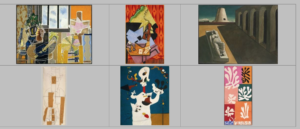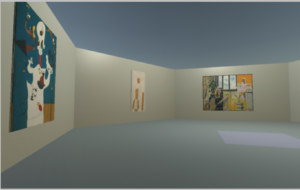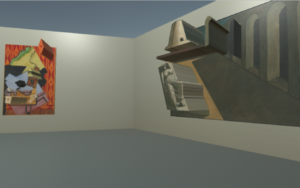In the scope of a large-scale online study, four interactivity modes (Observe, Explore, Manipulate and Contribute) were designed and developed. All the modes display the same digital content though four different enabled interactivities. In my research I have adopted Edmonds [2006] understanding of creative engagement with its three categories: attractors, sustainers and relaters. Attractors are concerned with gaining the initial attention of the user, sustainers with maintaining that attention throughout the interaction, and the relaters with linking to the long-term interest of the user.
In the design of the four interactivity modes, I have applied the definition of interaction by Parés and Parés [2001] and Roussou [2006], whereby explorative interaction is the ability to navigate freely in a virtual environment, manipulative interaction is the ability to manipulate objects within a virtual environment and contributive interaction is the ability to alter the environment itself, either in form or in function. Accordingly, the interactivity modes explore, manipulate and contribute have been designed with their corresponding tasks. In addition to these modes, I have also included the passive mode observe, with which I provide a reference for comparison between the active interactive modes and inactive user observation. The design description of the four modes is given below:
- Observe – inactive display of the images;
- Explore – presentation of the six paintings in a virtual galley context with enabled simple navigation through a first-person controller;
- Manipulate – presentation of the six paintings in a virtual gallery, where one or more paintings can be manipulated through dragging elements of the painting out;
- Contribute – presentation of the six paintings in a virtual gallery, where the user can choose a colour and change the background and the surroundings of the paintings.
The developed corresponding interactivity tasks are:
- Observe – look at the following paintings;
- Explore – navigate through the virtual gallery using the mouse and the arrow buttons;
- Manipulate – extract elements of the painting by pressing ‘play’ and using the mouse cursor to drag out elements of the painting (navigation is by the arrow buttons and the mouse);
- Contribute – add to the environment of the paintings by changing the colour of the walls, by using the pallets on the left (navigation is by the arrow buttons and the mouse).
Mentioned Literature:
E. Edmonds. On creative engagement. Visual Communication, 5(3):307–322, Oct. 2006.
N. Parés and R. Parés. Interaction-driven virtual reality application design (a particular case: El ball del fanalet or lightpools). Presence, 10(2):236–245, 2001.
M. Roussou. Interactivity and learning: Examining primary school childrens’ activity within virtual environments. London: University College of London, 2006.




